Weed whacker
From DDL Wiki
(→Components) |
(→Components) |
||
| Line 67: | Line 67: | ||
|- | |- | ||
! 03 | ! 03 | ||
| - | | Upper Shaft Axle || 1 || Translates power from engine to the lower part of the weed whacker || ??? || Steel || ??? || [[Image:weedwhacker_uppershaft2. | + | | Upper Shaft Axle || 1 || Translates power from engine to the lower part of the weed whacker || ??? || Steel || ??? || [[Image:weedwhacker_uppershaft2.JPG|200px]] |
|- | |- | ||
! 04 | ! 04 | ||
Revision as of 21:50, 18 September 2008
Contents |
Executive Summary
For our Engineering Design II project, we have decided to dissect and improve the 2-Cycle Straight Shaft Trimmer made by Troy-Bilt. We intend to improve its user functionality, the manufacturing process, and also reduce the impact the life of this product has on the environment. We will disassemble this trimmer in order to take a close look at all of its parts. By performing DFMA, FMEA, and DFE, we will carefully document our findings, decisions, and conclusions in order for our client to clearly see the merits in the product we have reinvented.
Stakeholders
There are several stakeholders that will be affected by our changes to this product. They include:
The manufacturer
Fulltime/partime gardeners
Lawn owners
Raw material suppliers
Gardening/home improvement stores
Product Usage
Usage of a weed whacker is very straight forward. For situations and areas where a lawnmower would be difficult to use, the hand-held weed whacker becomes a tool of choice. The convenience of this gardening tool comes from its ability to quickly cut vegetation in hard to reach places without damaging structures that may surround it.
In order to power on the weed whacker, first make sure there is sufficient gas in the tank. Click the on/off switch to on. Intructions on how to start the motor are included on a sticker on the straight shaft, and are as follows:
For a cold engine:
1. Press bulb 10 times.
2. Move blue choke lever to "1".
3. Squeeze trigger and pull rope 5 times.
4. Move blue choke lever to "2".
5. Squeeze trigger and pull rope till engine starts. If it doesn't start, repeat steps 1-5.
6. Let engine run 15-30 seconds.
7. Move blue choke lever to "3".
For a warm engine:
1. Move blue choke lever to "2".
2. Squeeze trigger and pull rope till engine starts.
3. Move blue choke lever to "3".
Once the engine is running, it is a simple matter of pointing the spinning wire towards the vegetation you wish to cut. If you wish to lengthen the wire, tap the bottom of the weed whacker to the ground, and a pre-measured length of wire will be added on. To stop the motor, simply press and hold the off button.
System Functions
After starting the engine, the weed whacker is controlled by a single trigger. This trigger controls the fuel feed to the engine allowing the user to change the rotational speeds of the two-cycle engine.
The power of the engine is transferred to an axle contained in the upper shaft. The axle is held in the center of the shaft using spacers. The end of the upper axle is shaped to slip over the end of the lower axle. The two axles connect using a square cross section that allows the power from the upper axle to completely transfer to the lower axle. To compensate for the possibility of misalignment, the two axles are made to be flexible.
The lower shaft is held to the upper shaft using the shaft clamp. This shaft clamp is screwed directly into the upper shaft, and holds the lower shaft by the metal nub.
At the bottom of the lower shaft, there is a large metal housing. Within this housing, there are four bearings and a set of bevel gears. The lower axle attaches to the bevel gear in the same manner as the two axles. Two bearings are placed on each end to keep the bevel gears in contact. With the gears, the power transfers completely from the lower axle to the weed whacker head.
Attached to the weed whacker head, is a reel that contains a long piece of wire. The wire is fed through two small holes exposing approximately 5 inches of wire. While the head is rotating, the wires are used to cut weeds. Due to the high speeds of the wire, there is no need for sharp edges, as the impact from the wire alone is enough to cut through plants.
Components
| Part # | Part Name | Qty | Function | Weight (Ounces) | Material | Manufacturing Process | Photo |
|---|---|---|---|---|---|---|---|
| 01 | Two Stroke Engine | 1 | Provides power to weed whacker | ??? | Steel, Plastic | Assembly Line Manufacturing | 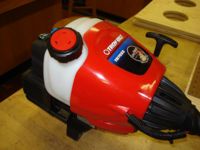
|
| 02 | Upper Shaft | 1 | Houses Upper shaft axle from the engine to the shaft clamp | ??? | Steel | ??? | 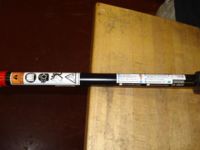
|
| 03 | Upper Shaft Axle | 1 | Translates power from engine to the lower part of the weed whacker | ??? | Steel | ??? | 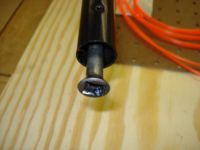
|
| 04 | Handle | 1 | To be held by user's offhand to hold the weed whacker properly | 11.2 | Plastic | Injection Molding | Image:Weedwhacker handle.jpg |
| 05 | Shaft Clamp | 1 | Clamps and secures upper shaft to the lower shaft | ??? | Steel | ??? | Image:Weedwhacker shaftclamp.jpg |
| 06 | Lower Shaft | 1 | Houses lower shaft axle from the shaft clamp down to the head case | ??? | Steel | ??? | Image:Weedwhacker lowershaft outer.jpg |
| 07 | Lower Shaft Axle | 1 | Mates with upper shaft axle to transfer engine's power down to the head case | ??? | Steel | ??? | Image:Weedwhacker lowershaft inner.jpg |
| 08 | Head case outer cover | 2 | Houses the bearings and bevel gears along with the weed whacker head | ??? | Steel | Cast | Image:Weedwhacker headcase outer.jpg |
| 09 | Ball Bearing | 4 | Facilitaes rotation of axle | ??? | Aluminum | ??? | Image:Weedwhacker headcase bearings.jpg |
| 10 | Bevel Gear | 2 | Translates the rotation of the axle such that the weed whacker head will be rotating parallel to the ground | ??? | Steel | ??? | Image:Weedwhacker headcase bevelgear.jpg |
| 11 | Shield | 1 | Shields user from debris that may be thrown up by the weed whacker wires | ??? | Plastic | Injection Molding | Image:Weedwhacker headcase shield.jpg |
| 12 | Weed Whacker Upper Head | 1 | Top half of weed whacker head. Houses the lower half of head. Rotated by the bevel gear attached to its shaft inside head case housing. | ??? | Plastic | Injection Molding | Image:Weedwhacker head upper.jpg |
| 13 | Braided Hose | 1 | Connects Dovetail Bottom-Line to marker body | 1.8 | Steel | Connections Headed and Threads Rolled, hose housing woven from metal sheet | 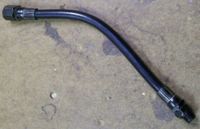
|
| 14 | Screw and Washer | 2 | Connects trigger handle to marker body | 0.1 | Steel | Heading and Thread Rolling | 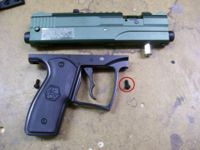
|
| 15 | Handle Covers | 2 | Provides comfortable grip for handle | 0.8 | Aluminum | Cast and finish machined | 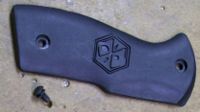
|
| 16 | Screw | 4 | Connects handle cover to handle | 0.1 | Steel | Heading and Thread Rolling | 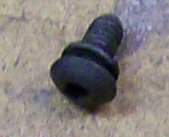
|
| 17 | Handle Trigger Assembly | 1 | Allows user to control firing of paintball. Double trigger controls release of bolt, firing paintball | 9.4 | Steel | Cast, Finish machined, finish ground, press fitting | 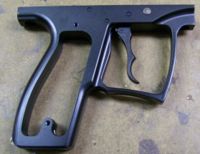
|
| 18 | MR1 Reservoir Plug | 1 | Seals compressed air resevoir and includes attachment point for valve spring | 0.8 | Aluminum | CNC Turned | 
|
| 19 | M5x12 Screw | 1 | Attaches Reservoir Plug to marker body | 0.1 | Steel | Heading and Thread Rolling | 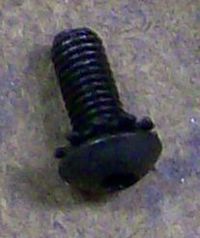
|
| 20 | Valve Spring | 1 | Provides pressure against cup seal to press valve pin into valve body | 0.1 | 5160 Steel | Coiled | 
|
| 21 | Cup Seal and Valve Pin Assembly | 1 | Seals hole in valve body so air does not leak out of air reservoir | 0.2 | Aluminum and Plastic (Nylon) | Finish machined and ground, Injection molded | 
|
| 22 | Valve Body | 1 | Routes air to Striker chamber and also to MR1 Venturi Bolt. | 0.2 | Aluminum | Turned and Drilled | 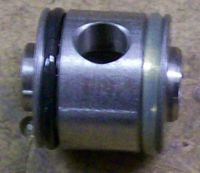
|
| 23 | Set Screw | 1 | Positions, orients, and secures air valve in marker body | <0.1 | Steel | Heading and Thread Rolling | |
| 24 | Cup Seal Guide | 1 | Centers Cup Seal and Valve Pin Assembly in air reservoir | 0.1 | Aluminum | Stamped | 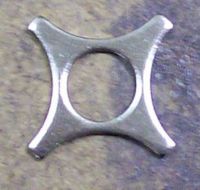
|
| 25 | Striker Spring | 1 | Applies force to Striker Bolt, accelerating it into the valve pin | 0.1 | 5160 Steel | Coiled | |
| 26 | Striker Plug | 1 | Seals Striker chamber. Also includes a spring guide for the Striker Spring | 0.8 | Aluminum | Turned and ground | 
|
| 27 | Striker Buffer | 1 | Helps protect Striker Plug and Striker bolt from damage during use from impact | <0.1 | Plastic | Extruded | 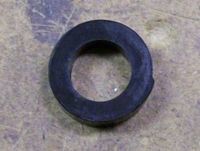
|
| 28 | Striker Bolt | 1 | Strikes Valve Pin, releasing air from air reservoir, through valve body and MR1 Venturi bolt. Striker Bolt releases when trigger is pulled. | 2.4 | Aluminum | Turned and milled flat section | 
|
| 29 | Quck Disconnect Pin | 1 | Secures Striker Plug to marker body | 0.3 | Steel | Cast | 
|
| 30 | MR1 Venturi Bolt | 1 | Directs air from valve body to paintball. Also stops additional paintballs from entering chamber when firing. | 1.6 | Aluminum | Turned and milled | |
| 31 | MR1 Pull Pin Cocking Knob | 1 | Connects Venturi Bolt to Striker Bolt. When Striker bolt is forced back into the cocked position by the compressed air, this pin pulls the Venturi Bolt back into the cocked position also. | 0.4 | Steel | Cast, Turned, Rolled | 
|
| 32 | Marker Body | 1 | Houses main components of paintball gun including, venturi bolt, striker, and valve assemblies. The barrel, trigger assembly, and stock also attach to the body | 14 | Aluminum | Cast and finish machined | 
|
| 33 | Misc. O-rings | 11 | O-rings help seal all the different chambers so compressed air does not leak out. This increases the efficiency of the paintball marker | <0.1 | Rubber | Injection molded and vulcanized | 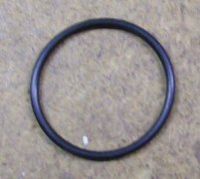
|
**Note: Some assemblies and parts were not disassembled in order to avoid destroying the parts.
Failure Mode Effects Analysis (FMEA)
| Item and Function | Failure Mode | Effects of Failure | S | Causes of Failure | O | Design Controls | D | RPN | Recommended Actions | Responsibility and Deadline | Actions Taken | S | O | D | RPN
|
|---|---|---|---|---|---|---|---|---|---|---|---|---|---|---|---|
| Engine | cell 1,1 | cell 1,2 | |||||||||||||
| Engine | Fouled spark plug | Engine won't start | 5 | Spark plug is dirty or broken | 5 | Fatigue testing | 5 | 125 | Approximate the life-span of the spark plug | - | |||||
| Carburetor | Engine won't idle | 5 | carburetor not adjusted properly | 5 | Fatigue testing | 5 | 125 | Add more lubricant | - |
| |||||
| Bevel Gears | Slip | Wire doesn't rotate | 5 | gears aren't properly aligned | 5 | Unalign gears and turn on | 5 | 125 | Check how much tolerance the shafts give the rod and gears | - | |||||
| Jam | Wire doesn't rotate | 5 | Not enough lubricant | 5 | Remove lubricant and turn on | 5 | 125 | Add more lubricant | - |
Design for Environment (DFE)
There are two main aspects of this product to scrutinize in order to reduce its impact on our environment - usage and production. Since the mechanics of how a weed whacker works are quite simple, there is little that can be done to reduce waste from the usage of this product. The mechanics that go into a weed whacker are frankly quite simple. From the explaination in the functionality section, it can be seen that there is very little power loss in the mechanical transfer of power from the engine to the rotating wires.
Usage
This particular weed whacker design uses a 2-cycle engine as its power source. This method is harmful to the environment, as it allows unused gasoline and oil to escape as exhaust.
Not only is it emitting a lot carbon dioxide and some hydrocarbons, it is also releasing unburnt gasoline. The gasoline vapors react with the sunlight creating even more carbon dioxide, nitrous oxides, and more volatile organic compounds. The inefficiency of the 2-cycle engine has a very large impact on green house gases and the environment.
